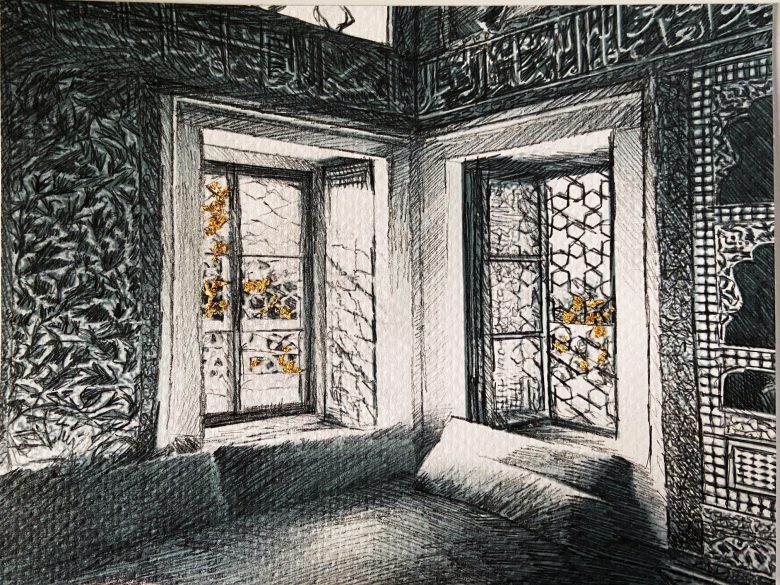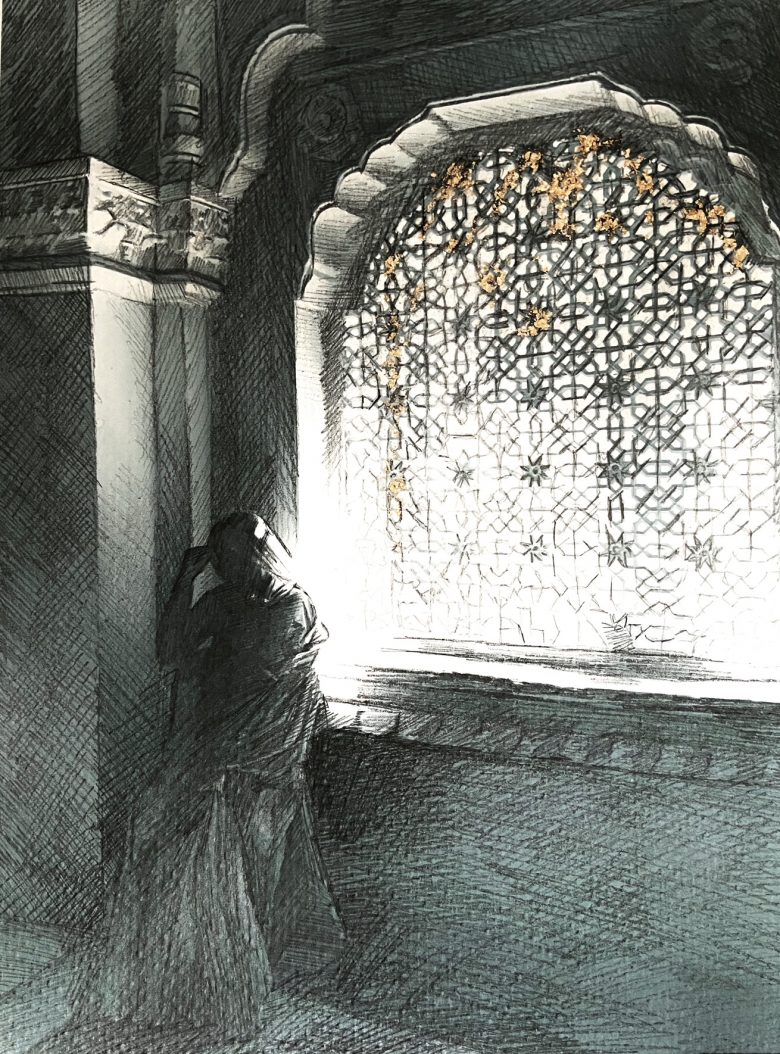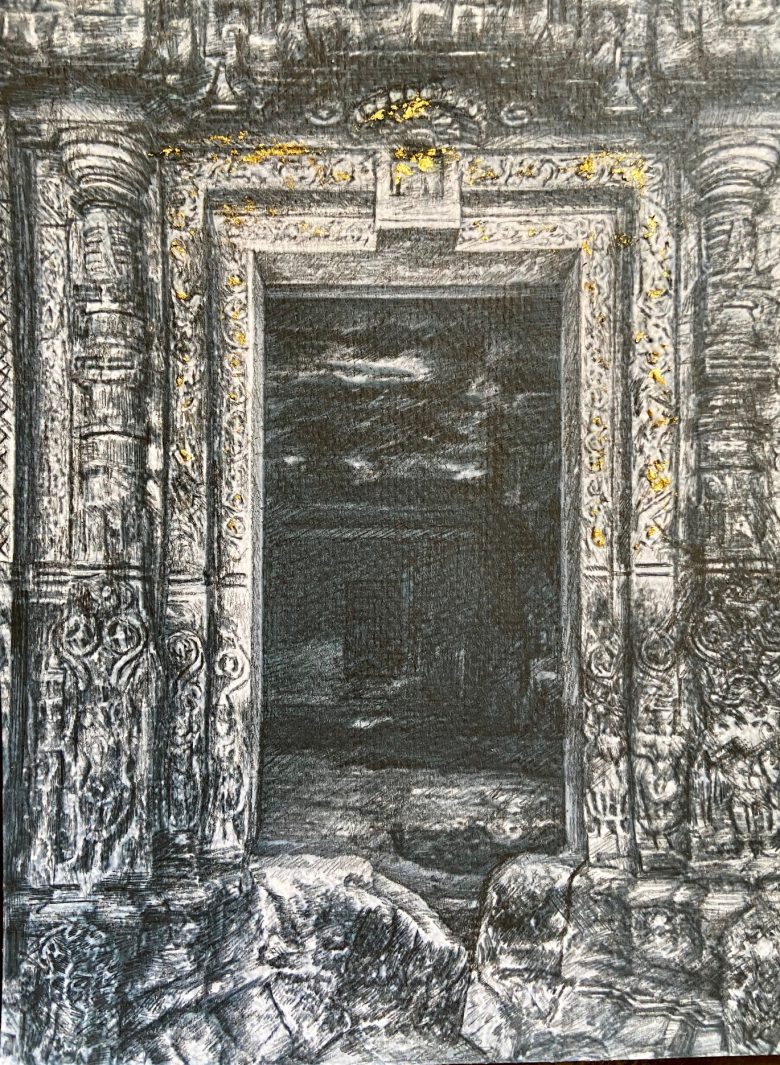

After learning about the animal cruelty that goes into paints, brushes, and really most traditional art materials, I threw my old supplies away and started on a new journey of ‘Vegan Art’. This has been a guiding force within my practice ever since. I use vegan, raw materials.
Shreya Mehta
J’AIPUR Journal: What is your background and how did you become an artist?
Shreya Mehta: I was born in Mumbai, moved to Belgium where I grew up, and have lived most of my adult life within the United States. Gujarati (Indian), Dutch, and English are all my mother tongues but maybe because of this, I’ve always found it easier to express myself through visual imagery rather than a single language.
 “Traces of Marrakech,” Charcoal, Graphite and 22K Gold Leaf on 150 lb Arches cold-pressed paper
“Traces of Marrakech,” Charcoal, Graphite and 22K Gold Leaf on 150 lb Arches cold-pressed paper
JJ: Describe your creative process.
Shreya: My creative process starts with a thought. Just like a seed needs water, soil, and conditions to grow into a plant, my thought needs inspiration and space. If a thought comes to me, I’ll transform it into a brainstorm of visual ideas on a notebook page because it allows me to see the potential in the idea. Next, using my favorite small samples as inspiration, I’ll create a larger finished piece of work. Once I start working on the larger piece, I begin to add the right conditions for it to grow— just like a plant. I think to myself:
What conditions does this work need to be created in?
Does it need to be created at 5 am in silence?
Does it need more explosive energy?
Does it need to be created in nature and surrounded by the wind?
Then, I begin to create by shutting off my external world and listening to either vibrations connected to the piece I’m working on, an inspiring mantra, or the sounds of nature. When the piece starts to speak to me, I’ll know it is ready to be let go. I am simply the medium through which the art is created.
JJ: Who are some women artists (living or dead) that you admire?
Shreya:
JJ: Name an art exhibition that had a lasting impression upon you.
Shreya: Random International’s immersive environment Rain Room (2012), at MoMA PS1. In a field of falling water that pauses wherever a human body is detected, Rain Room offered me the experience of controlling the rain, and therefore controlling the element of water.
JJ: What inspires you to create?
Shreya: Growing up, I wanted to be a doctor; my majors were biology and chemistry. However, the more I explored art, the more I found that science and art naturally overlap. Both are a means of investigation. Both involve ideas, theories, and hypotheses that are tested in processes where the mind and hand come together.
JJ: What are some tools, techniques and materials that you employ to create your work?
Shreya: After learning about the animal cruelty that goes into paints, brushes, and really most traditional art materials, I threw my old supplies away and started on a new journey of ‘Vegan Art’. This has been a guiding force within my practice ever since. I use vegan, raw materials. But beyond physical materials, I am also incorporating my body, spirit, and mind into my work. We live in a sea of vibrating energy – our bodies, our human material and the products we create. I want to use the purest of raw materials to translate these pure vibrations.
 “Traces of Rajasthan,” Charcoal, Graphite and 22K Gold Leaf on 150 lb Arches cold-pressed paper
“Traces of Rajasthan,” Charcoal, Graphite and 22K Gold Leaf on 150 lb Arches cold-pressed paper
JJ: How would you like to see your artistic practice/career evolve over the next few years?
Shreya: To break the glass ceiling as a woman artist.
JJ: How do you navigate the art world in terms of finding opportunities and building a collector base?
Shreya: Pre-Covid, I went as often as possible to exhibition openings because speaking to galleries and other artists is needed. There are many artists out there who would rather stay in their studio, do their creative thing, and not to be bothered by the people wanting to give them good money for their artwork. Resist the urge to shy away! Be open to inviting collectors and buyers into your studio space for a look behind-the-scenes. Stay in front of your customers and fans by asking them sign up for your newsletters and send them out monthly! Too many artists think their social media presence is enough and people can simply find them online.
JJ: What advice do you have for someone who wants to be an artist?
Shreya: Be authentic. Paint only what interests you in the way you choose to paint it. Don’t change your approach to gain sales, popularity or acceptance. You will never do your best work if you do. Compete only with yourself. Avoid competitions, contests and measuring yourself by how many shows you’ve gotten into or awards you’ve won. Seek validation internally; you will never please everyone. You have to realize it’s a lot of work. You can’t just sign up for a workshop or go to an art class once a week and expect gallery representation and collectors to follow shortly thereafter. Most successful artists have natural talent, a long history of education and a lot of practice under their belt. Your goal should be to be the best artist you are capable of being.
JJ: What are some challenges you have faced as an artist?
Shreya: Art is very time consuming on all levels. It is a beast that needs feeding regularly.
JJ: How do you think the art world can better support women artists?
Shreya: Be more of an activist. If you think somebody is doing a good job in the exhibition, museum or gallery space, be sure that you tell people. If an art fair has a high number of women in it, and the sales are good, art newspapers and magazines should be sure to point that out.
JJ: What do you like to do when you are not making art?
Shreya: I love to practice meditation which is something I do every day. I practice silent fasting on a regular basis (once a month) and I also commit to an 8 to 9 day silent retreat every year. During those days, I do not speak — no body language, no electronic communication, no human interaction of any sort. During these silent social fasts, I am within and completely internalized. All I do is create art, meditate, and write. This emptying of my mind is a necessary detox and a fountain of creative thinking and creation. This internalization—this journey within myself—is an endless source of creative inspiration for me. As a mother, wife, and daughter, I find this concentration on myself—the meditative exploration of who I am beyond an attachment to others—to be a creative, regularly tapped resource. “Traces of Temple Doorway,” Charcoal, Graphite and 22K Gold Leaf on 150 lb Arches cold-pressed paper
“Traces of Temple Doorway,” Charcoal, Graphite and 22K Gold Leaf on 150 lb Arches cold-pressed paper
Contact us if you are interested in more information about the artist and purchasing her works. We encourage you to support women artists to bring greater diversity into the art world!
